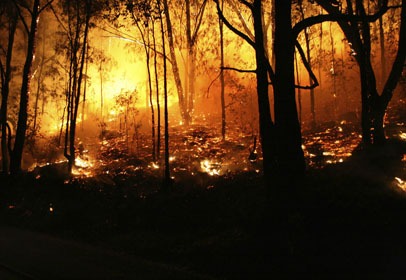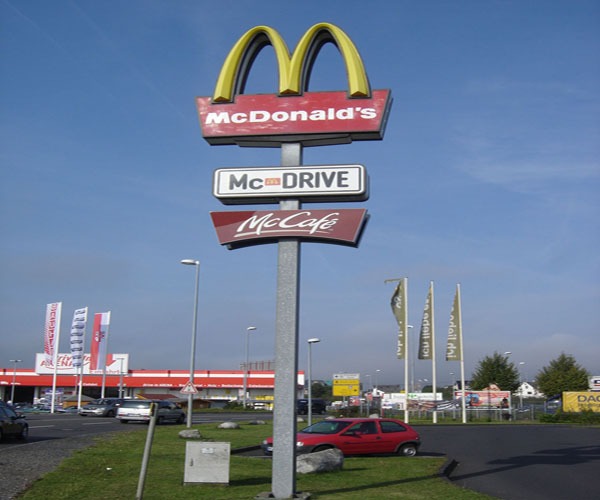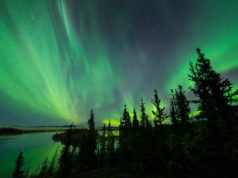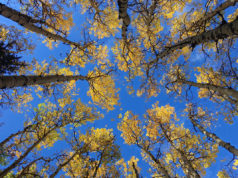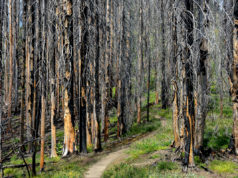Dear EarthTalk: How are droughts and wildfires cause by global warming? I thought warming mostly brought on wet and flooded conditions. – David Mossman,
By throwing the planet’s climate regulation systems out of whack, global warming is likely to cause more extreme weather events of every kind, including additional precipitation and flooding in some cases and more drying and drought in others—sometimes within the same region.
According to the Union of Concerned Scientists (UCS), a leading non-profit, increased temperatures on the Earth’s surface due to global warming accelerates evapotranspiration, an otherwise natural process that takes moisture from land, plants and water bodies and moves it skyward into the atmosphere.
“In drier regions, evapotranspiration may produce periods of drought—defined as below-normal levels of rivers, lakes and groundwater, and lack of enough soil moisture in agricultural areas,” reports UCS. “Precipitation has declined in the tropics and subtropics since 1970.
This drying trend is expected to continue through mid-century as the amount of land affected by drought grows significantly. Water resources in affected areas are predicted to decline by as much as 30 percent. “These changes occur partly because of an expanding atmospheric circulation pattern known as the Hadley Cell—in which warm air in the tropics rises, loses moisture to tropical thunderstorms, and descends in the subtropics as dry air,” adds UCS. “As jet streams continue to shift to higher latitudes, and storm patterns shift along with them, semi-arid and desert areas are expected to expand.”
The National Wildlife Federation (NWF) adds that the sea level rise expected to accompany global warming (as the polar ice caps melt) could further complicate matters for water-constrained areas by contaminating critical inland underground freshwater reserves with salt (so-called “saltwater intrusion”).
Another effect of unmitigated global warming will be a increased frequency of large wildfires and an expansion of burned over areas in already fire-prone regions like much of the Western U.S. NWF reports that researchers there are already noticing longer fire seasons, drier conditions persisting later into the year, and an increased frequency of lightning as thunderstorms are becoming more frequent and severe. The group adds that forest fires are expected to burn over twice as much of today’s affected areas across 11 western states by later this century if conservative predictions about warming come true.
So what can be done? NWF stresses that every one of us can play a role by cutting back on our fossil fuel use (less driving and flying, less home heating and cooling, more efficient appliances, etc.). Another way to help is to take into account our own water use and making a concerted effort to cut back and conserve this most vital of all natural resources. NWF also wants land managers and policymakers to consider global warming when choosing water management strategies to meet multiple demands and to work to protect natural forest and wetland systems that absorb flood waters and provide efficient water storage.
CONTACTS: UCS, www.ucsusa.org; NWF, www.nwf.org
Dear EarthTalk: Has the McDonald’s restaurant chain made significant improvements in recent years with regard to the environment? – Max Andria,
Long a poster child of environmental ills and health concerns, McDonald’s has worked steadily over the last two decades to clean up its act. The company will never win over vegetarians, who eschew meat for health, animal welfare and even world hunger concerns (we’d feed more people by using the land used to grow animal feed to grow food for people instead), but it has otherwise made some significant strides.
The company first came under fire from greens in the 1980s for sourcing beef for its hamburgers from ranches on newly cleared, former rainforest tracts throughout the Amazon basin. In response, the company committed in 1989 to refuse beef sourced from recently deforested rainforest areas.
Environmentalists were also on the company’s case about the waste it generates. So in 1990 McDonald’s partnered with the Environmental Defense Fund (EDF) and began phasing out its polystyrene “clamshell” food containers and increasing the recycled content of the other food containers and boxes it uses. EDF and the fast food giant developed a waste reduction plan that eliminated 300 million pounds of packaging, recycled a million tons of corrugated boxes and reduced waste by 30 percent in the decade that followed.
More recently, Greenpeace exposed the fact that expanded soy farming in
Likewise, McDonald’s beef purchasing executives have gotten in on things: In November 2010 the company was lead sponsor of the World Wildlife Fund’s first Global Conference on Sustainable Beef, an international meeting of stakeholders in the global beef system convened to discuss how to approach sustainable beef production in socially, environmentally and economically viable ways.
Another green highlight for McDonald’s is its commitment to matching 30 percent of the electricity used at its company-owned stores with renewable energy credits from American wind power providers. And several Japanese McDonald’s are participating in an energy-saving campaign employing 13 different green technologies with the goal of reducing greenhouse gas emissions by more than 20 percent overall.
While McDonald’s is moving in the right direction, it is still widely criticized for the waste it generates and its contribution to health woes such as obesity. For its part, the company has limited control over the 80 percent of its stores that are run by independent franchisees, so change under the golden arches is slow.
This past spring, McD’s released its Global Best of Green report highlighting advances made in energy efficiency, sustainable packaging, anti-littering and greening the workplace at hundreds of its restaurants around the world, underscoring it’s commitment to sustainability moving forward. The company hopes the new report will serve as a catalyst for franchisees to make similar improvements in their businesses.
CONTACTS: EDF, www.edf.org; Greenpeace, www.greenpeace.org; McDonald’s Best Practices, bestpractices.mcdonalds.com
Pic courtesy: iStockPhoto / harry_nl, courtesy Flickr
EarthTalk® is written and edited by Roddy Scheer and Doug Moss and is a registered trademark of E – The Environmental Magazine (www.emagazine.com). Send questions to: earthtalk@emagazine.com. Subscribe:www.emagazine.com/subscribe. Free Trial Issue: www.emagazine.com/trial.
More EARTHTALK QUESTION & ANSWERS IN ARCHIVE


